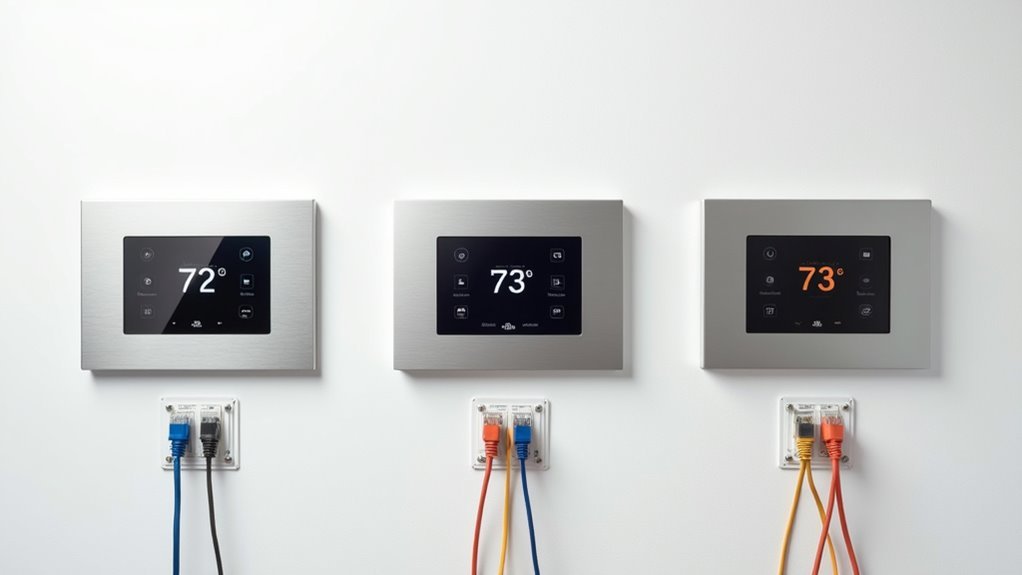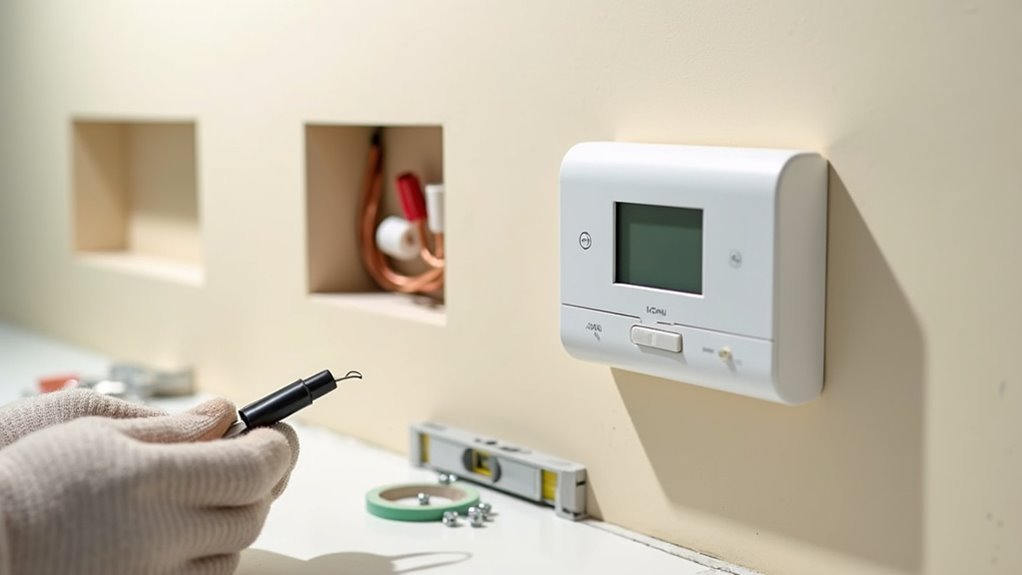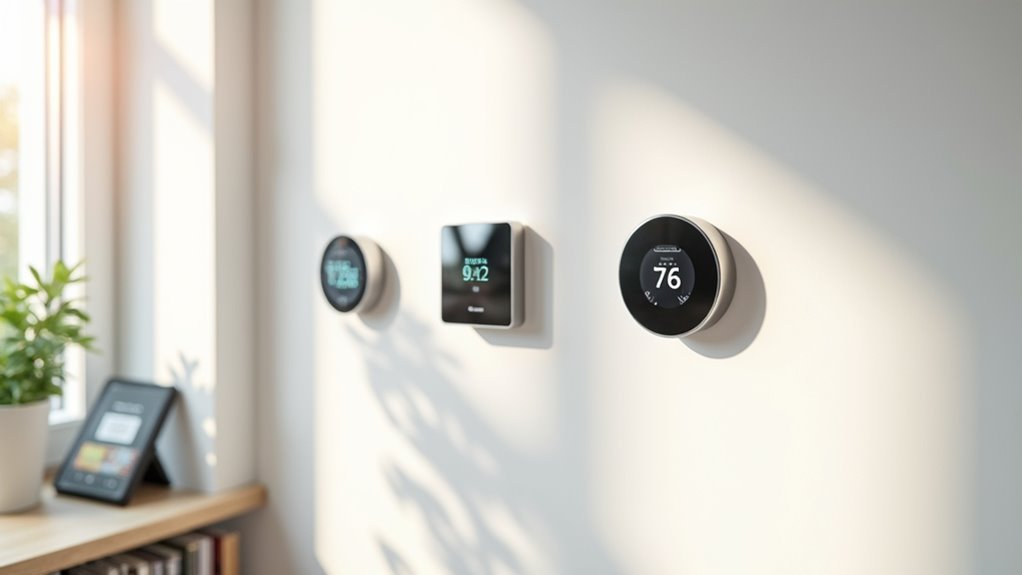You’ve probably put off upgrading your old thermostat because you’re worried about complicated wiring or expensive installation fees. The good news? Today’s smart thermostats are designed with DIY installation in mind, and most can be set up in under an hour with basic tools. Before you choose which model deserves a spot on your wall, there’s essential preparation work that’ll determine whether your weekend project becomes a success story or a frustrating setback.
Top DIY-Friendly Smart Thermostat Models

When you’re ready to upgrade your home’s climate control, several smart thermostat models stand out for their DIY-friendly installation processes.
The Ecobee Smart Thermostat Premium offers user-friendly guided app instructions and includes a remote sensor for enhanced temperature control.
Premium features meet simple setup with guided app instructions and remote sensor technology for precise temperature management.
Amazon’s Smart Thermostat provides an affordable option with seamless Alexa integration and straightforward setup steps.
Google’s Nest Learning Thermostat features intuitive installation with AI-driven learning capabilities for maximum energy savings.
The Honeywell Home RTH6580WF combines traditional controls with smart home integration, supporting both Alexa and Google Assistant.
Finally, the Sensi Touch Smart Thermostat delivers a responsive touchscreen interface with easy DIY installation.
Each model offers different features while maintaining simple installation procedures that most homeowners can complete themselves.
What You Need Before Starting Installation
Before you grab your screwdriver and start removing your old thermostat, proper preparation will save you time and prevent potential complications during installation.
First, verify your HVAC system’s compatibility with your smart thermostat, particularly checking for a C-wire since most Wi-Fi models need it for power.
Turn off power at the circuit breaker to eliminate electrical hazards before touching any wires.
Essential tools you’ll need include:
- Screwdriver, wire labels, and voltage tester for safe wire handling
- Installation manual and manufacturer video tutorials for guidance
- Trim kit if your new thermostat differs in shape from the old one
Review the installation manual thoroughly and watch manufacturer tutorials to understand specific requirements.
Having everything ready guarantees a smooth, professional-looking installation.
Step-by-Step Installation Process

Once you’ve gathered your tools and confirmed compatibility, begin by double-checking that power remains off at the circuit breaker before touching any wires. The installation process for smart thermostats requires methodical wire handling to guarantee your HVAC system functions properly.
| Step | Action |
|---|---|
| 1 | Remove old thermostat while labeling wires with colored stickers |
| 2 | Identify C-wire connection for Wi-Fi functionality |
| 3 | Connect labeled wires to corresponding terminals per manufacturer’s instructions |
| 4 | Level and secure new thermostat to wall |
After completing wire connections, restore power to your system. Download the manufacturer’s app for app-guided setup, which’ll walk you through connecting to Wi-Fi and configuring temperature settings. This systematic approach guarantees reliable operation of your new smart thermostat.
Troubleshooting Common Installation Issues
Even with careful planning, installation problems can arise that’ll leave you scratching your head. Don’t panic – most troubleshooting issues have straightforward solutions.
Don’t let installation hiccups stress you out – most problems have simple fixes once you know what to look for.
If your thermostat won’t power on, verify your HVAC system’s main power is active and check for secure connections. Missing a C-wire? Install a power extender kit to provide necessary voltage for smart features.
Temperature readings seem off? Relocate your thermostat away from heat sources, drafts, or direct sunlight that interfere with sensors.
For Wi-Fi connection problems, confirm your home network’s stability and verify the thermostat’s within router range.
Common installation fixes include:
- Double-checking labeled wire connections match your old configuration
- Ensuring all wire nuts are tight and properly secured
- Restarting both thermostat and router for connectivity issues
Maximizing Your Smart Thermostat’s Features

Why settle for basic heating and cooling when your smart thermostats can transform into a powerful energy-saving command center?
You’ll access significant energy savings by utilizing geofencing technology that automatically adjusts temperatures based on your location. Remote sensors monitor different rooms, optimizing your comfort level throughout your living space while maximizing efficiency.
Take advantage of scheduling capabilities to create temperature profiles for different times, ensuring comfort when you’re home and savings when away. Eco modes adjust settings based on your routines, potentially reducing bills by 26%.
Regular energy usage reports help identify patterns for informed adjustments. These home automation features work together, creating a seamless system that learns your preferences while minimizing energy waste.
Frequently Asked Questions
Can I Install a New Thermostat by Myself?
You can install a new thermostat yourself if you’re comfortable with basic wiring. Check your HVAC system’s compatibility first, especially for a C-wire, and follow the manufacturer’s step-by-step instructions carefully.
What Is the Easiest Thermostat to Install?
The Google Nest Learning Thermostat’s your easiest choice, scoring perfect marks for DIY installation. You’ll appreciate its intuitive app-guided setup and minimal wiring requirements that make installation straightforward even for beginners.
Is It Safe to Install Your Own Thermostat?
Installing your own thermostat can be safe if you turn off power first and follow manufacturer instructions carefully. However, if you’re uncomfortable with electrical work, you should hire a professional installer.
Can You Install a Smart Thermostat Yourself?
Yes, you can install a smart thermostat yourself. Most models offer app-guided setup and detailed instructions. You’ll need to check your wiring compatibility, especially for a C-wire, before starting the installation process.





Leave a Reply